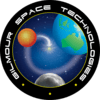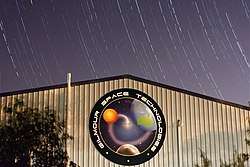Gilmour Space Technologies
Gilmour Space Technologies (also known as Gilmour Space, Gilmour Space Tech or GSpaceTech) is a leading venture-funded Australian space company headquartered in Queensland, Australia that is developing new hybrid-engine rockets and associated technology to support the development of a low-cost space launch vehicle.[1]
 | |
 Pimpama Engineering Facility, June 2017 | |
| Private | |
| Industry | space industry |
| Founded | July 17, 2012 |
| Founder | Adam Gilmour |
| Headquarters | |
Key people | |
| Services | Orbital rocket launch |
Number of employees | 47 |
| Website | www |
Its stated mission is to provide affordable space launch services to the world's fast-growing small satellite industry. The maiden launch of its first commercial orbital vehicle, called Eris, is planned for 2021 or 2022.[2] Their suborbital launch vehicle Ariel was set to launch in 2019.[3] Eventually, the company is also looking to provide low-cost space access for human spaceflight and exploration.[4]
Founding
Gilmour Space was founded in 2012 in Singapore by former banker, Adam Gilmour. In 2013, the Australian CEO & Founder set up similar operations in Queensland, Australia with his brother James Gilmour.[5]
The company's first project in 2013 was to design and manufacture high-fidelity spaceflight simulators and replicas for a number of space-related exhibits,[6] and education centers, including Spaceflight Academy Gold Coast, Australia's first astronaut training center.[5] It began its rocket development program in 2015; and within 18 months, successfully launched Australia and Singapore's first privately developed hybrid test rocket using proprietary 3D printed fuel.[7] The Gilmour brothers have also met with NASA officials at the Kennedy Space Center to discuss launch opportunities.[8]
Technology
Rocket Archetype

Gilmour Space employs a proprietary hybrid rocket motor technology that it believes overcomes many of the traditional challenges of hybrid rockets.[9] A hybrid-propellant rocket utilises a mixture of solid and liquid fuel. Advantages of hybrid rockets include acceptably high specific impulse values with relatively very low complexity and associated risks. In general, hybrid rocket engines are the safest of the three major rocket engines [10] – e.g. as compared to a solid-propellant rocket which cannot be deactivated or throttled (unless it is built in) once ignited; and a liquid-propellant rocket which typically requires cryogenic fuel storage and complex turbine systems to provide sufficient combustion chamber pressure both for the fuel and the oxidiser (hybrid-propellant rocket only requires pressurising the oxidiser).
Engine Development
Gilmour Space was the first private rocket company in Australia to launch a proprietary hybrid rocket in June 2016.[7] The RASTA launch vehicle is reported to have flown to an altitude of 5 km, and is said to the one of the world's first flight demonstrations of 3D printed rocket fuel.[11]
Since then, the Queensland-based company has conducted a series of large hybrid engine test fires, including a 17-second test in August 2018 that recorded 80kN (80,000 lbs) of thrust.[12][13]
A second test launch was attempted in June 2019, which failed in the final seconds on the launchpad due to an anomaly in the pressure system affecting the oxidiser tank.[14] According to the company, a detailed investigation into the anomaly resulted in 15 key recommendations that have since been implemented in the new orbital rocket design, and the company is now actively sourcing partners to test and manufacture its orbital launch vehicles in Australia.[15][16]
Deep Space & Exploration Research
Gilmour Space has also supported a number of proof-of-concept technology projects related to the development of a long-term space habitat. An example is the M.A.R.S (Mars Aqua Retrieval System) [17] rover project, a collaborative educational project at SUTD which received an award at the 2016 ASME international student competition.[18] and was featured in National Geographic’s Exploring Mars exhibit in Singapore.[19]
The company is also working on an in-space cubesat propulsion system, which could potentially be used to send a 1U cubesat from Earth's orbit to that of other moons or planets in the solar system.[20]
In Feb 2018, it signed a reimbursable Space Act Agreement with NASA to collaborate on various research, technology development and educational initiatives, including the testing of its MARS rover at Kennedy Space Center.[21]
Spaceflight Simulators
The company has earlier developed a number of unique high-fidelity spaceflight simulators and replicas, including a 6 degree-of-freedom space plane simulator, space capsule simulator, fighter cockpit trainers, low gravity climb, mission control simulators, and others.[22]
In February 2017, the Design Business Chamber of Singapore awarded Gilmour Space with the Singapore Good Design Mark (SG Mark 2017) for excellence in design and quality of its simulators.[23]
Funding and Awards
In fourth quarter 2016, its then-Singapore business was awarded a grant by the country's National Additive Manufacturing Innovation Cluster (NAMIC) to develop aerospace-related additive manufacturing capabilities with the Singapore University of Technology and Design (SUTD).[24]
In May 2017, Gilmour Space secured AUD 5 million in Series A round funding to develop and launch a low-cost launch vehicle for the small payload market. The lead investor was Australian venture capital firm Blackbird Ventures, with co-investors including global venture capital firm 500 Startups and other private investors.[1][4]
The company has also been awarded other grants by Advance Queensland[25] in Australia, and the Singapore Economic Development Board.
In June 2018, it received the Australian Trade & Investment Commission Innovation Award by the Australian Chamber of Commerce, Singapore "for the individual or organisation that has demonstrated innovation through bringing progressive and new ideas to business in priority sectors".[26]
In Sept 2018, the company became of the first Australian space companies to raise a Series-B investment round of USD 14 million, led by CSIRO venture capital arm, Main Sequence Ventures. [27]
In June 2019, Gilmour Space CEO Adam Gilmour was named the Advance Award winner in Advanced Manufacturing. The Advance Awards showcases the work of Australian citizens or residents who have made a significant global contribution overseas across selected industries.[28]
In Nov 2019, Adam was made a member of the Australian Space Agency's Space Industry Leaders Forum, which keeps the Agency informed on industry relevant issues and provides a coordination point for the civil space sector.[29]
In Dec 2019, Gilmour Space signed a statement of strategic intent with the Australian Space Agency as a demonstration of its commitment to launch Australia to space.[30]
References
- John Mcduling (May 30, 2017). "Blackbird shoots for the moon and Mars with Gilmour Space investment". Australian Financial Review. Retrieved June 2, 2017.
- "Gilmour Space website". Gilmour Space Technologies. Retrieved September 17, 2018.
- "Gilmour cleared for Queensland launch in May". Spatial Source. April 3, 2019. Retrieved January 25, 2020.
- Samuel Chan (February 27, 2017). "five questions with Gilmour Space Technologies". The Straights Times. Retrieved June 2, 2017.
- Andrew Potts (June 17, 2016). "Gold Coast company aims for stars at Pimpama". Gold Coast Bulletin. Retrieved June 2, 2017.
- "Fly like Bert with new Hinkler Hall exhibition". Bundaberg Regional Council. May 25, 2017. Retrieved June 2, 2017.
- Jack Harbour (July 29, 2016). "Gold Coast's first suborbital rocket successfully launched". Gold Coast Bulletin. Retrieved June 2, 2017.
- Linda Herridge (April 11, 2016). "Prospective partners attend partnership landscape forum at NASA's Kennedy Space Center". NASA. Retrieved June 2, 2017.
- Orie Cecil, Joseph Majdalani (December 2016). "Aerospace America". Aerospace America.
- Marshall Space Flight Center, Alabama (March 2010). "Nitrous Oxide/Paraffin Hybrid Rocket Engines" (PDF). NASA Tech Briefs. Retrieved June 2, 2017.
- hermes (August 3, 2016). "3D printing taking off in emerging 'space' in Singapore". The Straits Times. Retrieved November 6, 2019.
- "Gilmour Space 80kN test fire - video".
- "How this Australian startup built world's largest single-port hybrid rocket engine". Create. March 14, 2018. Retrieved November 6, 2019.
- "Gilmour Space remains unfazed". Gilmour Space 2019. Retrieved November 6, 2019.
- "Titomic and Gilmour Space to 3D print rocket parts as boost to Australian space industry". 3D Printing Industry. October 3, 2019. Retrieved November 6, 2019.
- "Gilmour Space and USQ collaborate on rocket tech". Spatial Source. June 4, 2019. Retrieved November 6, 2019.
- Eric Mack (August 25, 2015). "Designing a rover to mine for water on Mars". New Atlas. Retrieved June 2, 2017.
- SUTD-MIT IDC (2016). "Grand prize winner for Team MARS at ASME". SUTD-MIT International Design Centre. Retrieved June 2, 2017.
- Mohamed Firdaus Al-amin (November 11, 2016). "Five things to try at the Experience Mars showcase". The New Paper. Retrieved June 2, 2017.
- "Gilmour Space completes first of four tests for world's first interplanetary CubeSat propulsion system | SpaceTech Asia". SpaceTech Asia. August 2, 2017. Retrieved June 15, 2018.
- Grubb, Ben (February 19, 2018). "Aussie rocket brothers ink NASA deal as local space agency wait continues". The Sydney Morning Herald. Retrieved June 15, 2018.
- "Space Flight Academy". Retrieved June 2, 2017.
- Design Business Chamber of Singapore (2017). "Singapore Good Design 2017". Bundaberg Regional Council. Retrieved June 2, 2017.
- Lester Kok (January 23, 2017). "National cluster helps companies tap on new 3D printing technologies". NTU News Releases. Retrieved June 2, 2017.
- "Advance Queensland support for new rocket propulsion technology". Retrieved June 15, 2018.
- "AustCham President's Lunch & Business Awards 2018" (PDF). https://www.austcham.org.sg/default.aspx. June 8, 2018. Retrieved June 15, 2018. External link in
|website=(help) - "Australian startup raises $14 million for smallsat launchers". SpaceNews.com. September 28, 2018. Retrieved November 6, 2019.
- "Advance Australia recognises new space pioneer". Manufacturers' Monthly. September 11, 2019. Retrieved November 6, 2019.
- Department of Industry, Innovation and Science (November 18, 2019). "Space Industry Leaders Forum". Department of Industry, Innovation and Science. Retrieved January 23, 2020.
- "SCALING UP FOR THE NEXT GENERATION OF ROCKET TECHNOLOGY". Karen Andrews MP. Retrieved January 23, 2020.